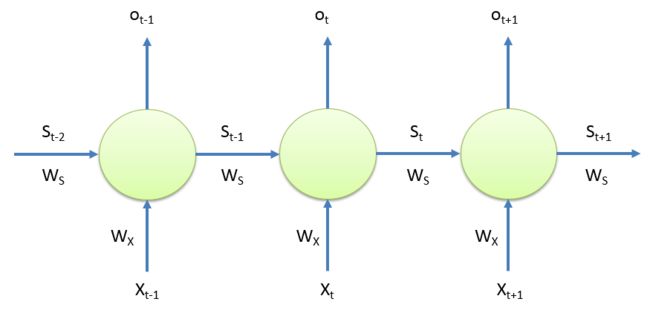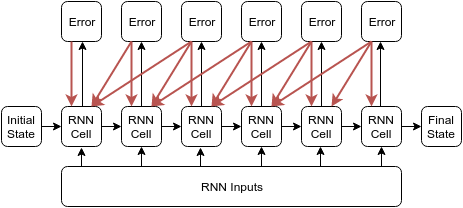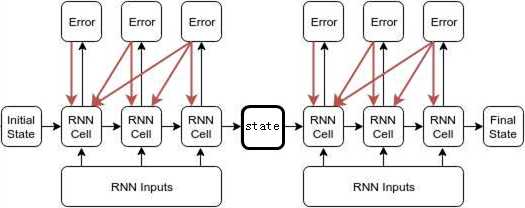关于Tensorflow中BATCH_SIZE,CELL_SIZE的讨论
本文转载自:https://zhuanlan.zhihu.com/p/31941650
这几天在看莫凡老师Tensorflow(以下简称TF)视频,被几个SIZE搞晕了,看了些资料,说说自己的理解,也和大家讨论一下。本人TF小白,还在学习中,请各位多多指教。
本文内容都是个人的一些观点,如有误,请及时指出,谢谢
话不多说,开始撸:
首先TF的几个关键的SIZE:
- INPUT_SIZE:输入数据维度
- OUTPUT_SIZE:输出数据维度
- BATCH_SIZE:批次大小,也即每次训练输入数据的个数
- TIME_STEPS:BPTT传播的时间层数,程序中也为n_step
- CELL_SIZE:隐藏层状态变量State的维度,或为STATE_SIZE
上面提到的几个SIZE,1和2相信大家能理解,关键在于3-5。
为此,我以莫凡老师RNN LSTM (回归例子)代码为基础,借助用LSTM预测股票每日最高价这个例子聊一聊这几个SIZE到底咋回事。
股票数据部分截图
CASE :
选取x和y各1000个作为训练数据,其中INPUT_SIZE=7,OUTPUT_SIZE=1。
设置BATCH_SIZE=1,TIME_STEPS=1000,CELL_SIZE=9。
(选择这些奇数是为了方面观察)
讨论:
首先声明,BATCH_SIZE * TIME_STEPS 必须等于数据长度,即1000;如果你取BATCH_SIZE=20,那么TIME_STEPS=50。
- TF的初始化
with tf.name_scope('inputs'):
self.xs = tf.placeholder(tf.float32, [None, n_steps, input_size], name='xs')
self.ys = tf.placeholder(tf.float32, [None, n_steps, output_size], name='ys')
输入x的shape为[None, n_steps, input_size],即[1,1000,7]
输出y的shape为[None, n_steps, output_size],即[1,1000,1]
- 输入层
def add_input_layer(self,):
l_in_x = tf.reshape(self.xs, [-1, self.input_size], name='2_2D')
Ws_in = self._weight_variable([self.input_size, self.cell_size])
bs_in = self._bias_variable([self.cell_size,])
with tf.name_scope('Wx_plus_b'):
l_in_y = tf.matmul(l_in_x, Ws_in) + bs_in
self.l_in_y = tf.reshape(l_in_y, [-1, self.n_steps, self.cell_size], name='2_3D')
将x转换为[-1,input_size],[1000,7]
权重w的shape为:[input_size, cell_size],即[7,9]
偏执b的shape为:[cell_size],即[9]
计算公式为:xW+b=y,shape计算为:[1000,7]*[7,9]=[1000,9]
所以y的shape为[1000,9]
输出时,将y转换为[-1, n_steps, cell_size],即[1,1000,9]
- 隐藏层
def add_cell(self):
lstm_cell = tf.contrib.rnn.BasicLSTMCell(self.cell_size, forget_bias=1.0, state_is_tuple=True)
with tf.name_scope('initial_state'):
self.cell_init_state = lstm_cell.zero_state(self.batch_size, dtype=tf.float32)
self.cell_outputs, self.cell_final_state = tf.nn.dynamic_rnn(
lstm_cell, self.l_in_y, initial_state=self.cell_init_state, time_major=False)
从输入层传过来的数据shape为[-1, n_steps, cell_size]
也可表示为[batch_size, n_steps, cell_size]
用数字代替就是[1,1000,9]
batch_size 为每一次训练输入X的个数(X的shape为[batch_size, cell_size]=[1,9])
n_steps 可以理解为隐藏层神经元的数量;
cell_size 实际上就是state_size,就是下图中S的维度;
RNN的隐藏层
对于每一个神经元:
隐藏层的S的shape为[batch_size, cell_size],即[1,9]
权重Ws和Wx的shape都为[cell_size, cell_size],即[9,9]
输出Ot的shape为[batch_size, cell_size],即[1,9]
对于整个隐藏层而言,由于有1000个神经元,则shape为[batch_size, n_steps, cell_size],即[1,1000,9]
- 输出层
def add_output_layer(self):
l_out_x = tf.reshape(self.cell_outputs, [-1, self.cell_size], name='2_2D')
Ws_out = self._weight_variable([self.cell_size, self.output_size])
bs_out = self._bias_variable([self.output_size, ])
with tf.name_scope('Wx_plus_b'):
self.pred = tf.matmul(l_out_x, Ws_out) + bs_out
输入数据转换[batch_size, n_steps, cell_size]—> [-1, cell_size]
即[1,1000,9]—>[1000,9]
权重w的shape为[cell_size, output_size],即[9,1]
偏执b的shape为[output_size],即[9]
计算公式为:xW+b=y,shape计算为:[1000,9]*[9,1]+[1]=[1000,1]
总结一下:
time_steps或者n_steps: BPTT传播的时间层数;
batch_size: 就是批次大小;
cell_size或者state_size: 就是隐藏层数据的维度,可自己设定。
补充:
这里讨论一下batch_size,time_steps和state_size名称的由来,用莫凡视频中提到的文章Styles of Truncated Backpropagation 中的图片讨论。
刚才我们假设batch_size=1就和上面这张图的效果类似。上图中,我们假设RNN Inputs包含6个x,并且被分在一个batch中,所以batch_size=1;RNN Inputs中每1个x都有一个神经元与其对应, BPTT传播时可从第6层传播到第1层,一共6层,所以time_steps=6;另一方面,也可以通过batch_size*time_steps来确认一下。
我稍微做一下修改:
和刚才一样,我们假设RNN Inputs包含6个x,但是他被分成了两个独立batch,所以batch_size=2;每个batch里面包含3个x,,BPTT传播时可从第3层传播到第1层,一共3层,所以time_steps=3;同样,也可以通过batch_size*time_steps来确认一下。
cell_size和state_size,怎么说呢,反正就是上图右边那个矩阵的维度。
如果你把上图左边的方框当作state,他就叫state_size;
如果你把上图左边的方框当作cell,他就叫cell_size。
整体上看:
time_steps因为跟时间层有关,所以叫time_steps;
batch_size因为表示分批个数,所以叫batch_size。
cell_size可以自己设定一个数,具体怎么取,取多少,我还不知道。





